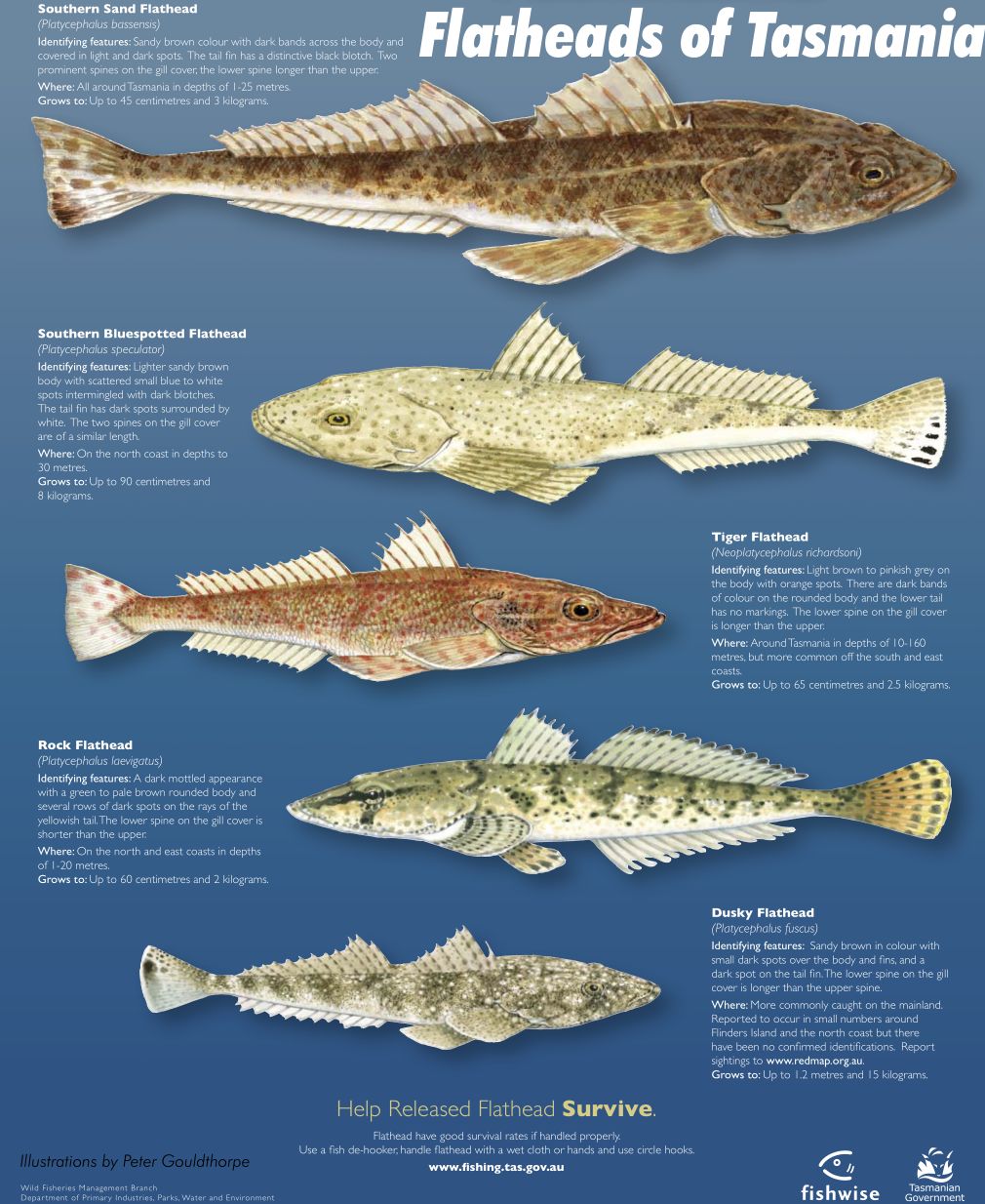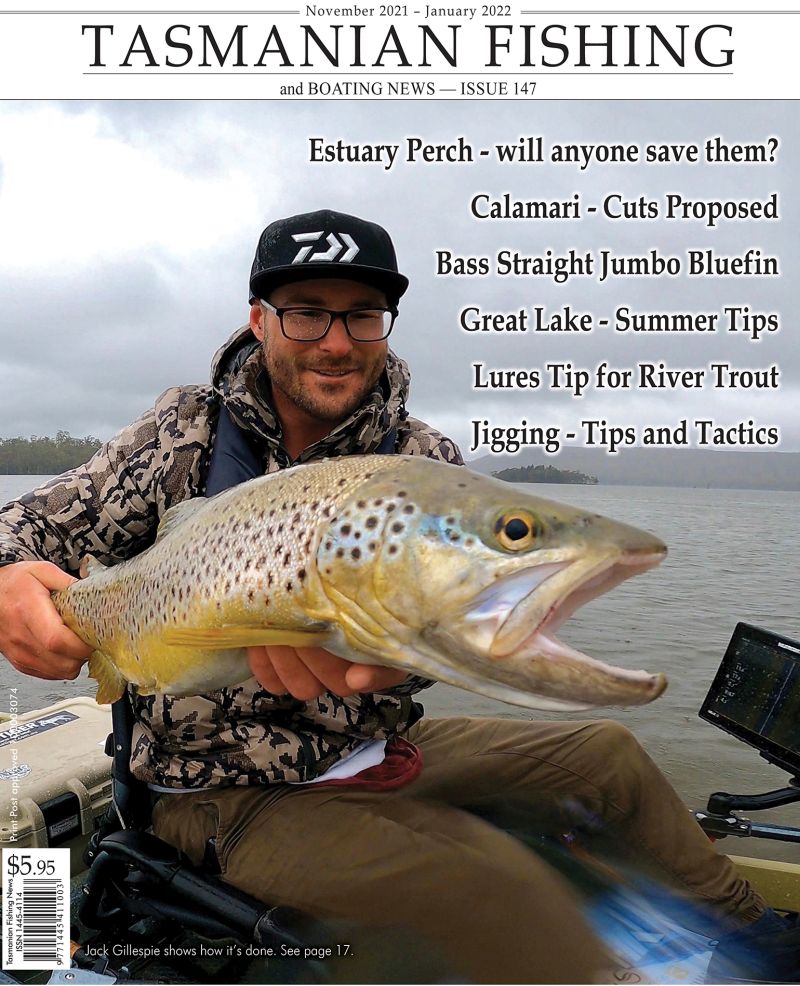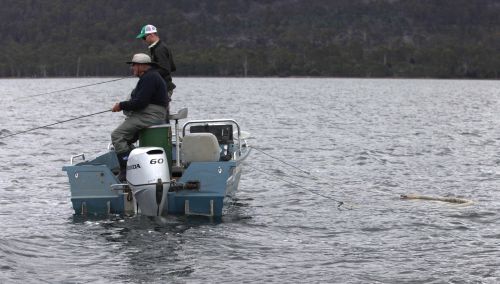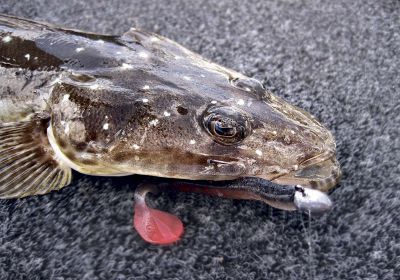 Presented from Issue 115, April 2015
Presented from Issue 115, April 2015
Heading home I take a hand off the wheel every now and then, rub my index finger over my thumb and smile.
Torn skin rough from lip gripping seven or more giant flathead. Picked up, photographed, and slipped back into Duck Bay.
A mission ‘long dreamed’, since the first time I pulled up at the jetty in Smithton a few years back. “Jeez. This looks fishy.”
And so, on a late-March weekend it happened. I’d found time away from the family, pieced together a little bit of local knowledge, cruised the web. Mike printed out satellite pics of low tide – the mysterious waterway undressed, exposing oyster leases, channels and drains.
On a mission to a new spot your senses are always straining to sense what might be important.
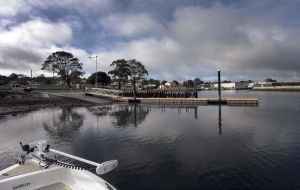 |
| Smithton has great boat launching facilities. |
At the boat ramp the still-wet weed marooned from the top of the tide was only a foot back from the top of the concrete. A big tide then, dropping now. Water pushing strongly past the two working boats tethered against the wharf.
We backed in, fired up, and let the outboard overwhelm the current, pinballing our way through the zigzag channel, maybe 10 or 12 short changes of direction, all well marked, to get us out into the heart of Duck Bay.
The wind was throwing up weather just short of chop. Maybe up to 15 knots, scudding showers. Our target species was the distinctive blue-spot flathead – you might call know them as ‘castelnaus’ that populate this part of the coast. The few photos I’d seen of them suggested they came in extra large sizes.
And so we found a drain adjacent to some oyster leases west of the main Duck Bay entrance and started fishing — two hours to the bottom of the tide.
There had been some extended talk about ‘first lure’ as you might expect. Clearly there are a few strong candidates for opening salvo. I went with a black and gold shad — plenty of action in the tail, lightish head to allow for some sublety through the water and 8lb leader. My fishing companion included the ordinarily sane Mike Stevens (also editor of this publication), he came up with an option more suited to jewelry in an early Madonna music video. You can skip this sentence if you’re looking for useful information except to say don’t bother rigging up with a shovel bibbed 4 inch hard body lure in shimmering pink.
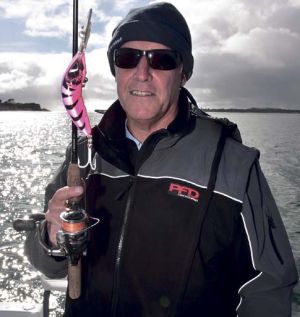 |
| Mike’s disco pink hard body lure didn’t work. |
For a couple of hours we fished hard. Using the electric to pull us up through the run-out current, working along drains, off the edge of flats, always near the leases that dominate this part of the waterway. Nothing — not a sniff so we changed plastics a couple of times — black and gold to white, white to pink. Mike occasionally looked wistfully at his disco hard body but thought better of it. I popped on an atomic chicken shad. Mike hooked a baby flattie and a salmon, otherwise it was hard work.
Was it local Marcus Popowski turning up, or was it the last breath of the tide? Marcus motored across the bay through the drizzle, pulled up beside us and offered two pieces of advice. ‘Cast right into the leases, and retrieve SLOW’.
He then motored 30 metres along the bank. Cast according to his own advice and BANG…hooked up to a 50cm plus blue spot flathead.
It was an emotional time on our boat as we gathered our pride, took photos of Marcus and his awesome fish, and scrambled to ‘have what he was having’.
Marcus was using a heavyish jig head, 3/8ths of an ounce, and a 4.5 inch bright green shad. That was the rig on both his rods so he was clearly confident in the approach.
The thinking was that getting down through the current and bumping the sand was important, as was finesse with the retrieve. Marcus chose a green colour scheme, and it seemed to him (and the flathead) to stand out.
As the tide hit dead low and started to run in the bite was on. We were still being outfished by the local but some great flathead came into our boat. Mike hooked a 55cm and it filled the net. The blue spots looking like opal specks through her scales.
For an hour it felt like one of us was either hooked up, reaching for the net or reaching for the camera. We started to broaden our plastics offerings. We did well with worm patterns in a couple of colours. I liked a four inch pearl curl-tail that hung on for a good few fish. The best fish would be lip gripped and lifted for a snap-shot then lowered back into the bay.
The catcher would wince before lifting…those sharp serrated flathead teeth about to dig into the flesh of the thumb…maybe a head-shake to make the point.
The best to the boat for us was a monster over 60cm. Clearly it was a female, huge shoulders, a real wedge shaped fish with iridescent markings.
We were all rigged with 8lb leader and none of us had a fish bite through our line. On balance it was worth taking the risk.
We were asking on the way home how critical it was to see Marcus fishing…would we have caught fish without him coming along? On balance we would have caught less. The super slow retrieve was critical. The flatties fought well, but to get the bite you need to be barely drifting the plastic past them. The other lesson was the tide, when it turned to run-in the bite was on, so we’d really focus on that for the next trip.
I’m planning it now, rubbing thumb and finger together, finding a weekend to get back to Duck Bay.
Leon Compton
Gallery
Jaiden Popowski with a 70.8cm Southern
Bluespot Flathead recently caught in the
Pirtek Fishing Challenge.
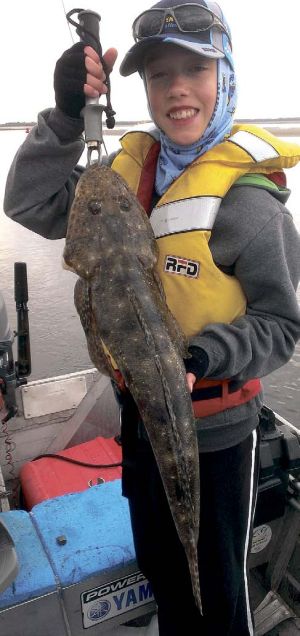
Marcus Popowski shows how it’s done
with this nice specimen first cast.
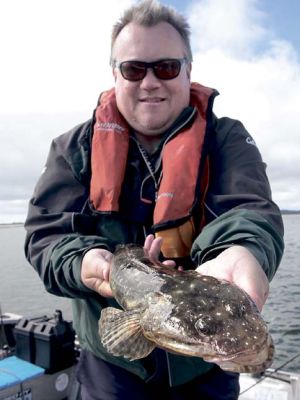
More from Marcus
Marcus Popowski puts his spin on flathead in his backyard.
Southern Bluespot Flathead (Platycephalus Speculator)
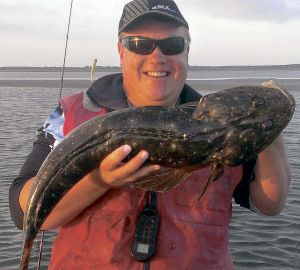 |
| Much fun is to be had using light gear on these large Southern Bluespot flathead. Braid with a flurocarbon leader is a favourite allowing the initial hit of the plastic to be felt. The larger fish seem to hang hard to the bottom with big head shakes trying to throw the plastic |
With the southern bluespot flathead currently receiving increased recreational fishing efforts across the North-West coast of Tasmania I was very keen to assist in being a fisheries ambassador for this species.
Very little research had been completed on the southern bluespot flathead and no foreseeable changes could take place unless some research was completed. I believe it is of utmost importance for the big estuary flathead to have some size and possession limits applied to them for sustainability. This would bring us into line with other mainland states and their current regulations on larger species of flathead.
This led to being involved in providing samples from July 2012 to September 2014 so that a population dynamics of the southern bluespot flathead could be determined, including growth, size at maturity modelling and age structure. At first this was a mind battle of ‘Science’ vs the ‘Release DNA’ that arose in me. The old saying “be cruel to be kind” was the best way for me of seeing a large southern bluespot be humanely killed and sent off to research labs instead of released to live another day. The majority found in our estuaries are females and they are in these estuaries in good numbers over the summer months to spawn.
It would have been about six years ago that I released my first large southern bluespot flathead. I must say, the releasing of this fish has had the biggest influence on my fishing hobby to date. Having been taken fishing from the day I could walk by my father, a flathead was just a flathead to me. For me there was no education on the five species we catch here in Tasmania - southern sand flathead, tiger flathead, rock flathead, dusky flathead and the southern bluespot flathead. A flathead was just a flathead, and hunting and gathering in whatever way
I could legally take them was all I was concerned about. Releasing my first large flathead instead of turning it into crumbed flathead nuggets turned out to be the best thing I could ever do in doing my little bit for the sustainability of fish in Tasmania. The enjoyment and smile that it puts on your face is indescribable and I strongly encourage if you have never released a prize trophy fish, try it, i dare you :). Since then releasing a large wild brown trout, or flathead to the ever common Australian salmon is just second nature and I actually enjoy releasing a fish more than keeping them. This often causes much anguish and questioning from nearby fishers, but I find is a great way of educating fellow fishers on catch and release and discussions on spawning fish, whether they ever take it on board is for them to determine. Now with modern technology and social media the ease of capturing a quick photo of your fish and releasing it is one of the best ways to preserve your fishing memories without having to take back a stiff, bent, discoloured trophy to show family and friends. Don’t get me wrong, I keep fish for a feed, and get much enjoyment from cooking up some fresh Tasmanian species for the family to enjoy. I find the southern bluespot flathead a softer meat than the popular common sand flathead, hence harder to skin and debone and far inferior to eat.
“A flathead just a flathead to me” mentality is an area where species recognition is going to be a huge education process with the Tasmanian recreational fishers. It was good to see Fisheries Tasmania recently releasing posters with the five species of flathead in Tasmania. Without education, species recognition, bag and size limits if introduced will be harder to comply with for the everyday fishers.
The banning of netting in Duck Bay and other surrounding inlets and rivers has seen an increase in fish numbers and a definite size increase. The increased popularity of soft plastic fishing has probably seen this take over as the preferred method of catching the southern bluespot flathead in shallow estuaries instead of bait, flounder light and spear methods that I was brought up with. Unfortunately these methods do not lend themselves to catch and release. With bait fishing these large flathead often are gut or gill hooked and retrieving hooks are nearly impossible without damaging the fish. Spear fishing is a popular method (having spent many years enjoying this method), but a high percentage of these large flathead often found in a foot of water or less at night. They are such a strong fish that they end up ripping free from the spear and swimming off with significant head and gill injuries, with a slow death nearly inevitable.
Nutting out the methods and what works best to catching these large flathead has been addictive. This is also an expensive one with a continued flood of new soft plastics and jig heads entering the market. I’ve had a blast on the water with friends and meeting new people in fishing circles from social media sites. Watching them catch a new flatty personal best gives me much enjoyment. Spending time on the water with my four children is something I would never swap for anything. Let’s hope some sensible size and bag limits are put on our estuary flathead so many generations ahead can enjoy the lure of catching a ‘big one’.
Marcus Popowski
Flathead information http://dpipwe.tas.gov.au/sea-fishing-aquaculture/community-resources/fish-factss
Flathead Posters http://dpipwe.tas.gov.au/sea-fishing-aquaculture/publications-and-products/fishes-of-tasmania-posters
